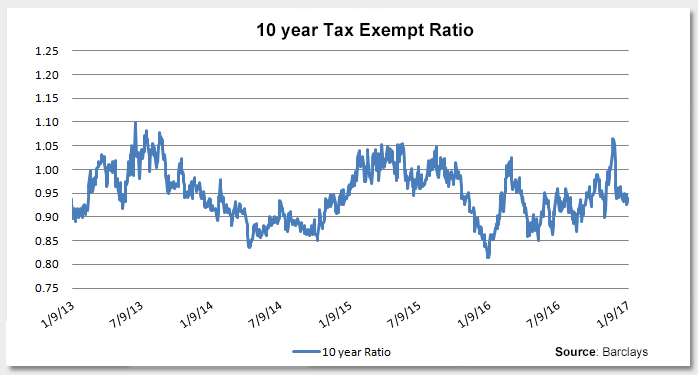The tax exempt municipal market is poised to confront many challenges in 2017. The market will need to adjust to a new environment in terms of policy, governance, rates and volatility. The November 2016 election results have highlighted the real possibility of change and the tax exempt municipal market reacted with heightened volatility in the weeks following the election. As this week’s chart reflects, 10-year tax exempt ratios (the yield on AAA tax exempt 10-year bonds relative to the Treasury yield) spiked on investor concerns for the secondary effects of tax reform. Ratios jumped over 105% while the long-term average is close to 90%.
New policy, including infrastructure investment and tax reform, combined with a higher interest rate back drop will continue to spur volatility in the coming year. New infrastructure spending could give rise to increased issuance, while lower marginal tax rates may lead to reduced demand for municipals. However, an infrastructure spending program that includes a modified form of the Build America Bond program (with a lesser Federal subsidy) is a possible outcome that could greatly limit supply pressures in the tax exempt market.
Given the current rate environment and the tightening bias from the Federal Reserve, issuance for refunding should diminish meaningfully and support exempt valuations. For the past several years, the municipal market new issue calendar has been driven by refunding volumes as issuers take advantage of historically low rates. New money issuance has been muted as issuers have generally reigned in discretionary spending.
Tax reform can come in various structures. Another proposal includes capping the benefit of the tax exemption at 28% for investors. This could have significant ramifications for the municipal market. Although the likelihood of this, or similar reform, being passed is rather remote, even consideration of such policy could lead to notable market volatility.
Key Takeaway:There is much anticipation for change to be implemented in Washington D.C. this year, including tax reform and infrastructure spending. These headline-making proposals could very well be ground breaking, but I see the execution of any legislation to have a more delayed impact (and of course the devil is in the details). Further, it is likely we see episodes of volatility during the year surrounding policy proposals which will provide ample opportunities for investors seeking relative value, much like what was experienced in November 2016 following the elections.
The material provided here is for informational use only. The views expressed are those of the author, and do not necessarily reflect the views of Penn Mutual Asset Management.
This material is for informational use only. The views expressed are those of the author, and do not necessarily reflect the views of Penn Mutual Asset Management. This material is not intended to be relied upon as a forecast, research or investment advice, and it is not a recommendation, offer or solicitation to buy or sell any securities or to adopt any investment strategy.
Opinions and statements of financial market trends that are based on current market conditions constitute judgment of the author and are subject to change without notice. The information and opinions contained in this material are derived from sources deemed to be reliable but should not be assumed to be accurate or complete. Statements that reflect projections or expectations of future financial or economic performance of the markets may be considered forward-looking statements. Actual results may differ significantly. Any forecasts contained in this material are based on various estimates and assumptions, and there can be no assurance that such estimates or assumptions will prove accurate.
Investing involves risk, including possible loss of principal. Past performance is no guarantee of future results. All information referenced in preparation of this material has been obtained from sources believed to be reliable, but accuracy and completeness are not guaranteed. There is no representation or warranty as to the accuracy of the information and Penn Mutual Asset Management shall have no liability for decisions based upon such information.
High-Yield bonds are subject to greater fluctuations in value and risk of loss of income and principal. Investing in higher yielding, lower rated corporate bonds have a greater risk of price fluctuations and loss of principal and income than U.S. Treasury bonds and bills. Government securities offer a higher degree of safety and are guaranteed as to the timely payment of principal and interest if held to maturity.
All trademarks are the property of their respective owners. This material may not be reproduced in whole or in part in any form, or referred to in any other publication, without express written permission.


